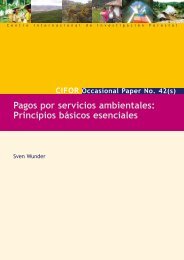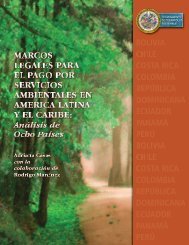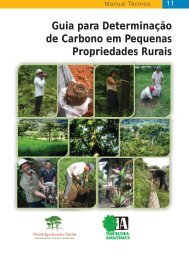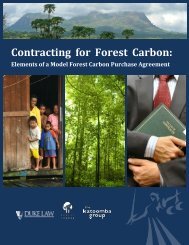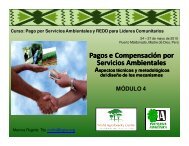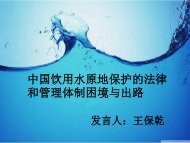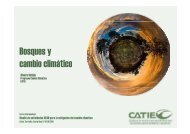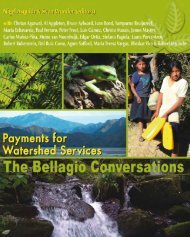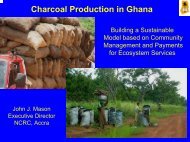Guide on Climate Change and Indigenous Peoples
Guide on Climate Change and Indigenous Peoples
Guide on Climate Change and Indigenous Peoples
- No tags were found...
You also want an ePaper? Increase the reach of your titles
YUMPU automatically turns print PDFs into web optimized ePapers that Google loves.
increase 6 <strong>and</strong> limit their chances of participati<strong>on</strong>in social life <strong>and</strong>/or in pursuing other alternativesources of income. 7 Women also have to exertgreat efforts collecting, storing, protecting <strong>and</strong>distributing drinking water. 8• Violati<strong>on</strong> of Rights. In pastoralistcommunities, cases of fathers trading theirdaughters as young as eight or nine as dowriesto replace their income from lost livestock due toprol<strong>on</strong>ged drought have been documented. 9 Death of livestocks for lackof water also makes them more dependent <strong>on</strong> internati<strong>on</strong>al food aid.Women <strong>and</strong> girls trekking for a l<strong>on</strong>g distance to look for water, food <strong>and</strong>firewood are at risk to various forms of violence. Girls also have to dropout from school to find water <strong>and</strong> wood resources in distant places orto care for ill relatives. The loss of opportunity for, aside from issues ofaccess to, educati<strong>on</strong> has a lifel<strong>on</strong>g <strong>and</strong> multiple impact for indigenousgirls. This lessens indigenous girls’ chances of exercising, accessing <strong>and</strong>claiming their rights especially the right to full development as humanbeings.• Migrati<strong>on</strong> <strong>and</strong> Displacement. Food insecurity due to drought or floodingwould likely drive migrati<strong>on</strong> that interrupts <strong>and</strong> limits opportunitiesfor educati<strong>on</strong>. Families headed by women due to migrati<strong>on</strong> of men seas<strong>on</strong>allyor for a number of years experience poverty while the workloadsof women, their children <strong>and</strong> elderly increase. Whole families migratingto overpopulated cities are at high risk of getting HIV/AIDS. 10 Migrati<strong>on</strong><strong>and</strong> displacement - as direct or indirect impact of climate change <strong>and</strong>adaptati<strong>on</strong>/mitigati<strong>on</strong> measures - reinforces the discriminati<strong>on</strong> <strong>and</strong>violence already experienced by indigenous women, exposing them tohigher risks of trafficking, exploitati<strong>on</strong> <strong>and</strong> gender-based violence.• Less Mobility <strong>and</strong> Further Marginalizati<strong>on</strong>. As primary carers orcaregivers of the family, the women have to spend more time caring forsick family members, making them less mobile with no time to engagein social <strong>and</strong> political activities<strong>and</strong> their own pers<strong>on</strong>al development.• Loss of Identity. The totalimpact of climate change <strong>on</strong>indigenous women is the erosi<strong>on</strong>of their world views, culture <strong>and</strong>identity which are intricately wovenin their relati<strong>on</strong>ship to their l<strong>and</strong> <strong>and</strong>resources.“Many aspects of Saami culture -language, s<strong>on</strong>gs, marriage, childrearing<strong>and</strong> the treatment of olderpers<strong>on</strong>s - are intimately linkedwith reindeer herding. If reindeerherding disappears, it will have adevastating effect <strong>on</strong> the wholeculture of the Saami people..”- Olav Mathis-Eira, Sami Council.Source: MRG. State of Minorities Report2008.112 <str<strong>on</strong>g>Guide</str<strong>on</strong>g> <strong>on</strong> <strong>Climate</strong> <strong>Change</strong> <strong>and</strong> <strong>Indigenous</strong> <strong>Peoples</strong>



